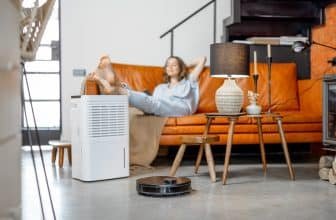Air Purifiers for Allergy and Asthma Sufferers: Improving Quality of Life with Clean Air
Air purifiers have become increasingly popular in recent years, especially for individuals with respiratory diseases and allergies. These devices are designed to improve indoor air quality by removing harmful particles and allergens from the air. This can significantly reduce symptoms for individuals with respiratory conditions such as asthma, chronic obstructive pulmonary disease (COPD), and allergies.

For people with allergies and asthma, air purifiers can be a game-changer. These devices can help improve the quality of life for individuals by reducing the amount of allergens and irritants in the air. This can lead to fewer symptoms, such as coughing, wheezing, and shortness of breath, and can help individuals breathe easier. Air purifiers can also help reduce the risk of respiratory infections and other health issues associated with poor indoor air quality.
Breathe Easier: Air Purifiers as a Solution for Allergies and Asthma
- Air purifiers can significantly improve the quality of life for individuals with respiratory diseases and allergies.
- These devices can reduce symptoms and help individuals breathe easier by removing harmful particles and allergens from the air.
- Air purifiers can also help reduce the risk of respiratory infections and other health issues associated with poor indoor air quality.
Understanding Air Purifiers
Air purifiers are devices that help to improve indoor air quality by removing pollutants and allergens from the air. They are particularly useful for people with respiratory diseases and allergies, as they can help to reduce symptoms and improve quality of life.
Types of Air Purifiers
There are several types of air purifiers available on the market, each with their own unique features and benefits. Some of the most common types of air purifiers include:
- HEPA filters: These are high-efficiency particulate air filters that are designed to capture particles as small as 0.3 microns. They are highly effective in removing allergens such as dust, pollen, and pet dander from the air.
- Carbon filters: These filters are designed to remove odors and gases from the air. They are particularly useful for people with chemical sensitivities or those who live in areas with high levels of pollution.
- Ionizers: These devices work by emitting negatively charged ions into the air, which attach to positively charged particles such as dust and pollen. This causes the particles to become heavy and fall to the ground, where they can be easily vacuumed or swept up.
- UV lights: These devices use ultraviolet light to kill bacteria, viruses, and other microorganisms in the air. They are particularly useful for people with respiratory infections or those who are immunocompromised.
How Air Purifiers Work
Most air purifiers work by using a combination of filters and/or other technologies to remove pollutants and allergens from the air. As air is drawn into the purifier, it passes through one or more filters that capture particles such as dust, pollen, and pet dander. Some air purifiers also use ionizers or UV lights to further purify the air.
Key Features of Air Purifiers
When choosing an air purifier, there are several key features to consider. These include:
- True HEPA filter: This is a type of HEPA filter that meets strict standards for particle filtration. It is highly effective in removing allergens and other pollutants from the air.
- Three-stage filtration: This refers to air purifiers that use multiple filters to remove different types of pollutants from the air. For example, a purifier might use a pre-filter to capture large particles, a HEPA filter to capture smaller particles, and a carbon filter to remove odors and gases.
- Ozone: Some air purifiers use ozone to purify the air. However, ozone can be harmful to people with respiratory diseases and should be used with caution.
Overall, air purifiers are an effective way to improve indoor air quality and reduce symptoms for people with respiratory diseases and allergies. By choosing the right type of purifier and considering key features such as filter type and three-stage filtration, people can enjoy cleaner, healthier air in their homes and workplaces.
Health Benefits for Allergy and Asthma Sufferers
Air purifiers are an effective way to improve indoor air quality and reduce the number of airborne allergens that can trigger allergies and asthma attacks. Here are some of the health benefits of air purifiers for allergy and asthma sufferers:
Reducing Airborne Allergens
Air purifiers can help reduce the number of airborne allergens in the home, such as dust, pollen, and pet dander. According to a Healthline article, air purifiers with HEPA filters are particularly effective at removing these allergens from the air. HEPA filters can capture particles as small as 0.3 microns, including most allergens.
Alleviating Asthma Symptoms
Air purifiers can also help alleviate asthma symptoms by removing the allergens that can trigger them. According to a Verywell Health article, air purifiers can help people with asthma control their symptoms by removing allergens like dust and pollen from the air. This can help prevent asthma attacks and improve overall quality of life.
Preventing Asthma Attacks
Air purifiers can also help prevent asthma attacks by removing the allergens that can trigger them. According to a GoodRx article, air purifiers with true HEPA filters and carbon filters are particularly effective at removing allergens from the air. They can also help improve indoor air quality by removing pollutants like smoke and VOCs, which can also trigger asthma attacks.
In conclusion, air purifiers are an effective way to improve indoor air quality and reduce the number of airborne allergens that can trigger allergies and asthma attacks. They can help alleviate asthma symptoms, prevent asthma attacks, and improve overall quality of life for allergy and asthma sufferers.
Air Quality and Respiratory Diseases
Air quality is an important factor in maintaining good health, especially for people with respiratory diseases and allergies. Poor air quality can exacerbate symptoms and lead to a decrease in quality of life. Air purifiers can help alleviate some of these symptoms by removing harmful particles from the air.
Indoor Air Quality Factors
Indoor air quality can be affected by a variety of factors including mold, pollutants, dust mites, smoke, and environmental triggers. According to the American Lung Association, “indoor air pollution can actually be worse than outdoor pollution in some cases.” This is because indoor air is often trapped and recirculated, allowing pollutants to build up over time.
Mold is a common indoor air quality issue that can cause respiratory problems, especially for people with allergies. Dust mites are another common indoor allergen that can cause symptoms such as sneezing, runny nose, and itchy eyes. Smoke, whether from cigarettes or other sources, can also be a significant contributor to poor indoor air quality.
Impact of Poor Air Quality on Health
Poor air quality can have a significant impact on health, especially for people with respiratory diseases and allergies. Exposure to pollutants such as volatile organic compounds (VOCs) and air pollution can cause respiratory irritation, inflammation, and even damage to the lungs.
According to the Environmental Protection Agency (EPA), “people with asthma, allergies, or other breathing conditions may be more sensitive to the effects of indoor air pollution.” This is because their respiratory systems are already compromised, making them more susceptible to the negative effects of poor air quality.
Air purifiers can help improve indoor air quality by removing harmful particles from the air. They work by using filters to trap pollutants and other allergens, such as dust and pet dander. Some air purifiers also use UV-C light technology to kill germs and bacteria.
Overall, air purifiers can be an effective tool for improving indoor air quality and reducing the negative effects of poor air quality on respiratory health.
Choosing the Right Air Purifier

Considering Room Size and Weight
When selecting an air purifier, it is crucial to consider the size of the room where it will be used. Different air purifiers are designed to accommodate varying room sizes, so it is important to match the purifier’s capacity to the dimensions of the space. Additionally, the weight of the air purifier should be taken into account, especially if it needs to be moved between rooms or levels of the home.
Filter Types and Maintenance
The type of filters an air purifier uses is a critical factor to consider. HEPA filters are highly effective in capturing small particles, making them ideal for allergy and asthma sufferers. Carbon filters are beneficial for removing odors and volatile organic compounds. It is also important to consider the maintenance of the filters, such as whether they are washable or require regular replacement.
Additional Features to Consider
When choosing an air purifier, it is beneficial to look for features such as the Minimum Efficiency Reporting Value (MERV) rating, which indicates the filter’s efficiency, and the Clean Air Delivery Rating (CADR), which measures the purifier’s effectiveness in removing pollutants. Indicator lights can provide convenient notifications for filter replacement and overall air quality, enhancing the user experience and ensuring optimal performance.
Living with Allergies and Asthma

People with allergies and asthma often struggle to breathe easily and comfortably in their own homes. The constant presence of allergens can exacerbate symptoms, leading to a decrease in quality of life. However, there are several strategies that can be implemented to help alleviate these symptoms and improve overall health.
Environmental Control Strategies
One of the most effective strategies for managing allergies and asthma is to control the environment. This can involve measures such as using air purifiers to remove allergens from the air, keeping humidity levels low to prevent the growth of mold and dust mites, and using allergen-proof bedding and pillowcases.
Lifestyle and Home Adjustments
In addition to environmental control strategies, lifestyle and home adjustments can also be helpful in managing allergies and asthma. For example, regularly cleaning the home can help prevent the accumulation of dust and other allergens. Additionally, avoiding tobacco smoke and other irritants can help reduce symptoms.
Medical Management
For those with more severe allergies and asthma, medical management may be necessary. This can involve the use of medications such as asthma inhalers or allergy shots, as well as the development of a treatment plan or asthma action plan with an allergist or other healthcare professional. It is important to follow these plans closely to ensure optimal management of symptoms.
Overall, living with allergies and asthma can be challenging, but there are many strategies that can be implemented to help improve quality of life. By using environmental control strategies, making lifestyle and home adjustments, and working with healthcare professionals to develop a treatment plan, individuals with allergies and asthma can breathe easier and live more comfortably.
The Role of Technology in Air Purification

Air purifiers have come a long way in recent years, thanks to advancements in technology. Today’s air purifiers are smarter, more efficient, and more effective than ever before. In this section, we will discuss the role of technology in air purification and how it is helping allergy and asthma sufferers.
Smart Air Purifiers and Apps
One of the latest advancements in air purification technology is the development of smart air purifiers and apps. Smart air purifiers are equipped with sensors that can detect the air quality in a room, adjust the fan speed accordingly, and send alerts to the user’s phone when the filters need to be changed. Some smart air purifiers even have voice-activated controls, making it easier for users to adjust the settings without having to get up from their seats.
Apps for air purifiers allow users to monitor the air quality in their homes and control their air purifiers remotely. Users can set schedules, adjust fan speeds, and receive alerts when the filters need to be changed. Some apps even provide real-time air quality data, allowing users to see how their air purifiers are improving the air in their homes.
Advancements in Filtration Technology
Another area where technology has made significant advancements is in filtration technology. High-efficiency particulate air (HEPA) filters are the gold standard for air purification, as they can remove particles as small as 0.3 microns. However, new filtration technologies are emerging that are even more effective at removing pollutants from the air.
Portable air cleaners equipped with ionizing air purifiers use electrostatic charges to trap pollutants, which are then removed from the air by the purifier’s filters. These purifiers can remove particles as small as 0.01 microns, making them ideal for people with severe allergies or asthma.
In conclusion, technology has played a significant role in improving the effectiveness of air purifiers. Smart air purifiers and apps make it easier for users to monitor and control the air quality in their homes, while advancements in filtration technology have made air purifiers even more effective at removing pollutants from the air.
Common Concerns and Misconceptions

Air purifiers can be a valuable tool for people with respiratory diseases and allergies. However, there are some common concerns and misconceptions that can lead to confusion about their effectiveness and safety. In this section, we will address some of the most common concerns and misconceptions about air purifiers.
Addressing Ozone Emissions
One of the most common concerns about air purifiers is the emission of ozone. Ozone is a type of gas that can be harmful to the respiratory system, especially for people with asthma or other respiratory diseases. While some air purifiers do emit ozone, it is important to note that not all air purifiers are created equal. Some air purifiers use technology that produces very low levels of ozone, while others do not emit ozone at all.
To ensure that an air purifier is safe to use, it is important to look for products that have been certified by reputable organizations such as the California Air Resources Board (CARB) or the Association of Home Appliance Manufacturers (AHAM). These organizations have strict standards for ozone emissions and can help consumers make informed decisions about which air purifiers to choose.
Understanding Ionizers and UV Lights
Another common concern about air purifiers is the use of ionizers and UV lights. Ionizers work by releasing negatively charged ions into the air, which attach to positively charged particles such as dust, pollen, and pet dander. This causes the particles to become heavy and fall to the ground, where they can be vacuumed up or swept away.
UV lights, on the other hand, work by emitting ultraviolet radiation that kills bacteria, viruses, and other microorganisms in the air. While both ionizers and UV lights can be effective at improving indoor air quality, it is important to note that they can also have some drawbacks. For example, ionizers can produce ozone as a byproduct, while UV lights can be harmful to the eyes and skin if not used properly.
Debunking Myths About Air Purifiers
Finally, there are some common misconceptions about air purifiers that can lead to confusion about their effectiveness. One of the most common myths is that air purifiers can completely eliminate indoor air pollution. While air purifiers can certainly help to reduce the amount of pollutants in the air, they cannot completely eliminate them.
Another common myth is that air purifiers are noisy and disruptive. While some air purifiers can be noisy, many models are designed to operate quietly and unobtrusively. In fact, some air purifiers are so quiet that they can be used in bedrooms while sleeping.
In conclusion, air purifiers can be a valuable tool for people with respiratory diseases and allergies. By addressing common concerns and misconceptions, consumers can make informed decisions about which air purifiers to choose and how to use them safely and effectively.
Integrating Air Purifiers into Daily Life

Air purifiers can be a valuable addition to the daily routine of those who suffer from respiratory diseases and allergies. By removing harmful particles from the air, air purifiers can help to improve the quality of life for those who suffer from these conditions. Below are some tips for integrating air purifiers into daily life.
Placement and Usage Tips
When it comes to air purifiers, placement is key. For optimal performance, air purifiers should be placed in the room where the person spends the most time. This is typically the bedroom, but it could also be the living room or home office. It is important to keep the air purifier away from walls and furniture to ensure that air can circulate freely.
It is recommended to run the air purifier continuously, especially during allergy season. This will help to keep the air clean and free of allergens. Some air purifiers come with a timer or automatic shut-off feature, which can be helpful for conserving energy and reducing noise levels.
Combining Air Purifiers with Other Solutions
While air purifiers can be effective on their own, they can be even more effective when combined with other solutions. For example, opening windows and doors to improve ventilation can help to circulate fresh air throughout the home. However, during allergy season, it is important to keep windows closed to prevent pollen and other allergens from entering the home.
Heating and air conditioning systems can also impact air quality. It is important to keep these systems clean and well-maintained to prevent the circulation of dust and other particles. Additionally, using a humidifier can help to add moisture to the air, which can reduce the amount of airborne allergens.
Vacuuming regularly can also help to reduce the amount of allergens in the home. It is recommended to use a vacuum with a HEPA filter, which can trap small particles like pollen, pet dander, and dust mites.
In summary, integrating air purifiers into daily life can be a simple and effective way to improve the quality of life for those who suffer from respiratory diseases and allergies. By following these placement and usage tips, and combining air purifiers with other solutions like ventilation, heating, air conditioning, humidifiers, and vacuuming, individuals can create a healthier living environment.
Future Trends and Innovations

As technology continues to evolve, air purifiers are becoming more advanced and efficient in removing pollutants from the air. This is good news for people with respiratory diseases and allergies, as air purifiers can help improve their quality of life. Here are some emerging technologies and research and development that could shape the future of air purifiers.
Emerging Technologies in Air Purification
One of the most promising emerging technologies in air purification is photocatalytic oxidation (PCO). PCO is a process that uses UV light to activate a catalyst that breaks down pollutants in the air. This technology has the potential to remove a wide range of pollutants, including volatile organic compounds (VOCs) and bacteria. It is also energy-efficient and produces no harmful byproducts.
Another emerging technology is electrostatic precipitation (ESP). ESP uses an electrical charge to remove particles from the air. This technology is already used in some commercial air purifiers, but researchers are working to make it more efficient and effective in removing smaller particles.
Research and Development
Researchers are also exploring new materials and designs for air purifiers. One area of focus is nanotechnology, which involves using tiny particles to capture pollutants. For example, researchers are developing air filters made from carbon nanotubes, which have a large surface area and can capture a wide range of pollutants.
Another area of research is the use of natural materials, such as plants, to purify the air. Plants are known to absorb pollutants and release oxygen, so researchers are exploring ways to incorporate plants into air purifiers. This could be a more sustainable and natural alternative to traditional air purifiers.
In conclusion, the future of air purifiers looks bright, with new technologies and research promising to make them even more effective in removing pollutants from the air. As the technology continues to evolve, people with respiratory diseases and allergies can look forward to breathing cleaner and healthier air.
Frequently Asked Questions
What are the top recommended air purifiers for individuals with asthma and allergies?
According to the American Academy of Allergy, Asthma & Immunology, the top recommended air purifiers for individuals with asthma and allergies are those with HEPA filters. HEPA filters are designed to trap small particles, such as pollen, dust, and pet dander, which can trigger allergic reactions and asthma symptoms.
How do HEPA air purifiers specifically benefit those with asthma?
HEPA air purifiers can help individuals with asthma by removing common asthma triggers from the air, such as dust mites, mold spores, and pet dander. By reducing exposure to these triggers, individuals with asthma may experience fewer asthma symptoms, such as coughing, wheezing, and shortness of breath.
Can the use of air purifiers exacerbate allergy symptoms in some cases?
While air purifiers can be helpful for individuals with allergies, they can exacerbate symptoms in some cases. For example, if the air purifier is not properly maintained, it can become a breeding ground for mold and bacteria, which can worsen allergy symptoms. Additionally, if the air purifier produces ozone, it can irritate the lungs and worsen asthma symptoms.
What features should one look for when choosing an air purifier for allergic rhinitis?
When choosing an air purifier for allergic rhinitis, it is important to look for one with a HEPA filter, as well as additional features such as a pre-filter to capture larger particles, a carbon filter to remove odors, and an ionizer to attract and trap particles. It is also important to choose an air purifier that is appropriately sized for the room in which it will be used.
In what ways can air purifiers contribute to improving the quality of life for allergy and asthma sufferers?
Air purifiers can contribute to improving the quality of life for allergy and asthma sufferers by reducing exposure to common triggers, such as pollen, dust, and pet dander. This can lead to fewer symptoms and a better overall quality of life. Additionally, air purifiers can help to improve indoor air quality, which can have a positive impact on overall health and well-being.
What criteria do asthma foundations consider when recommending air purifiers?
When recommending air purifiers, asthma foundations consider a variety of factors, including the type of filter, the size of the unit, the noise level, and the cost. Additionally, they may consider the specific needs of the individual, such as the severity of their asthma and the presence of other respiratory conditions.






